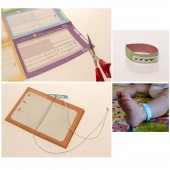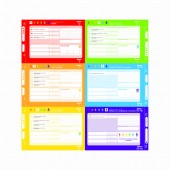Child Health & Vaccination Info System Health and Vaccination card by Lisa Scharoun |
Home > Winners > #33052 |
 |
|
||||
| DESIGN DETAILS | |||||
| DESIGN NAME: Child Health & Vaccination Info System PRIMARY FUNCTION: Health and Vaccination card INSPIRATION: The challenge to create a new health and vaccination card for mothers in developing countries was posed by the Bill & Melinda Gates foundation in a 2013 competition entitled "Records for Life." According to the Foundation: "The (child health) record is critical to ensure safe and effective vaccination because it Identifies children who need to be immunized, have missed immunizations, or are off schedule. Unfortunately, many families never receive child health records for their children, or they lose the records. Even when families have the records, they are not always accurately filled out because they may be designed in a confusing way." The challenge was to create a document that would be both easy to use by literate and illiterate people, accessible and highly visible in the home, with the ability for health care workers to easily add information and for the parents to have a unique reminder and identifier for their child in order to remember to come to a health clinic for future vaccinations. The core concept of the final design solution is a wearable identifier - a color coded bracelet system which correlates to each vaccination period and a hanging pouch to protect the card and used bracelets. This aligns with many traditional religious and cultural practices of placing bracelets or amulets on babies - often blessed by shamans or priests - for protection against evil, harm and disease. As a concept this aligns well with the practice of vaccination - as babies are protected from harmful and life threatening illnesses. The material choice - Tyvek - was a natural choice as the designer reflected on the use of Tyvek bracelets in hospitals, at concerts and other events in which water-proof, non-transferrable unique identifiers are necessary Worn on the ankle of a child - it is a highly visual reminder of the need to return for further vaccinations. It can also be kept as a keepsake for the parent as a reminder of that stage of the child's development. UNIQUE PROPERTIES / PROJECT DESCRIPTION: The design assists mothers in developing countries to remember to vaccinate their children and to keep a life long documentation of their child's health and vaccination status. The design incorporates a color coded vaccination card with integrated bracelets to uniquely identify the child and the vaccinations administered. Color-coding identifies each vaccination/age period and gives a visual progression through the cycle of vaccinations in accordance with the child’s age. Attached to each section is a matching colored bracelet, which is to be cut from the card at the time of vaccination, and attached to the child’s ankle or wrist. The bracelet will identify the current vaccination cycle and will also have symbols which identify the vaccinations that have been given. Each color coded section will have a written reminder for the next vaccination period. The colorful bracelet is a constant visual reminder for parents to continue vaccinations. Bracelets are to be printed on Tyvek - a material that makes them non-transferrable, waterproof and tear resistant and are therefore the ideal personal identifier. The bracelet size is adjustable as the health worker can cut it to measure to the wrist/ankle and then trim the excess. Additionally, the vaccination card has a section for personal details along with space for an adhesive QR (quick response) code that can be linked to an electronic medical records system and is stored in a pouch with a pocket for the used bracelets that has a section for writing the child’s name and address. OPERATION / FLOW / INTERACTION: According to the Alma Sana study, wearable bracelets are an effective and constant means to remind mothers to vaccinate their children. The current design minimizes the amount of materials in the production of the object and the reliance on custom objects (like a small hole punch as used in the Alma Sana design) to make the system function. The bracelets are also integrated into the card so that they work as a system instead of separate items. Along with integration - the bracelets do not need to be resized as they can "grow" with the child and be sized to the child at the time of application. Bracelets attached to the child have the next dose date written on them and are a visual reminder to the parent daily to return for further vaccinations. Vaccination dates have been translated from weeks to months to allow the family to understand time for next vaccination in a coarser measure such as months. Each vaccination has been given a unique symbol which is reflected on the card and respective bracelet for that period. Vaccination symbols aids the family in understanding the number of vaccinations and dosages required for the child. The record is sized at 474 X 490 mm to enable easy readability and usage. It is folded down into six sections to fit into the provided pouch, which contains an elastic string for hanging. When hung in a dwelling the pouch will act as another constant reminder for the need to return for vaccinations as it will have the next dosage date visible in the die-cut section on the front. Colour coding is also an effective means to show time progression. The vaccination card includes several elements that assist with the collection and tabulation of government statistics on vaccination levels. These are the use of QR codes, which can be directly linked to an electronic medical records system using a smart phone or personal scanner, color-coding the vaccination cycles and the use of symbolic representations of vaccinations. Color-coding and symbols for vaccinations can be used by policy makers to categorize vaccination coverage across age and to identify specific vaccinations that are being under implemented. PROJECT DURATION AND LOCATION: The project started in August 2013 and was completed in October 2013 in Canberra, Australia. It was selected as a top 10 finalist and an award winner for "ability to add information" in the "Records for Life" competition Bill & Melinda Gates Foundation and was displayed at the 2014 IxDA conference in Amsterdam in February 2014. FITS BEST INTO CATEGORY: Social Design |
PRODUCTION / REALIZATION TECHNOLOGY: The card and pouch are made out of the extremely durable material Tyvek. Tyvek, a material developed by Dupont, is created of very fine polyethylene fibers, seven times finer than human hair, spun in a random pattern and bonded together with heat and pressure. It is incredibly durable, tear resistant and unaffected by water. However, like paper, it can be printed on by any standard printer and can be written on with most writing utensils. Tyvek is a commonly used material and is in stock at most commercial printers. It is available at a reasonable price point in relation to paper of similar thickness. A double pocket pouch, printed Tyvek in a fold-able design that requires no adhesives in its construction, has been created to protect the health card. It protects the card and also works with the card as an integrated system; next dosage dates for vaccinations are presented prominently on the bottom of each month section on side A of the card and align with the die-cut area on the front of the pouch as a highly visual reminder for the parent. The function of the second pocket is to hold the completed vaccination bracelets. SPECIFICATIONS / TECHNICAL PROPERTIES: x 1 double sided health card Size (custom): 474 x 490 mm Printed double sided on 190gsm Tyvek paper with adhesive tabs applied to the back of bracelets on side B. x 1 double pocket pouch Size (custom): 370 X 495 mm printed single sided on 190gsm Tyvek paper x 1 elastic cord Size: 1 meter long x 3mm width double knotted at the ends TAGS: Child Health, Vaccination, Information design, Graphic Design, Visual Communications RESEARCH ABSTRACT: A study by Usman et. al (2011) on the impact of a re-design of the vaccination card in rural Pakistan was used a framework for this project. In the study, Usman et. al created a larger card in a bright yellow colour contained in a plastic pouch with a hanging string. Simply by redesigning these simple elements of the card - the research team recorded a significant increase the in the number of vaccinations over the period of a year. Another key study referenced was the Alma Sana project, initiated in 2009 by Cornell University student Laura Braun. In the study, Braun researched the use of a silicone bracelet to remind illiterate, rural Peruvians to vaccinate their children. This project, funded by the Gates Foundation in 2012, uncovered that a printed silicon bracelet with mnemonic symbols was an effective means to remind mothers to vaccinate their children and to identify remaining vaccinations to health care workers. The Child Health and Vaccination Information system incorporated methods from both studies to provide an integrated design to give the health worker a single document with organized sections for them to record pertinent information such as vaccinations completed, reminders for next visit, growth and development of the child and additional notes per appointment and for the parent - regardless of their literacy level - essential information on vaccination periods; follow up dates for vaccination and the basics for growth and nutrition in children 0-18 months. The card functions by once administering the vaccination, the health worker can then tick boxes and write any notes on the card in the specified color-per-age section, fill in the section for “next dose date,” cross out the symbols on the bracelet, cut the bracelet away from the card and place on the baby’s leg or wrist and return the card to the pouch with the “next dose date” showing in the die-cut window of the carrying pouch. Should the parent forget or lose the vaccination card, move or go to another clinic, the bracelet on the baby will aid the health worker in identifying the child’s age and vaccination status. Vaccination dates have been translated from weeks to months to allow the family to understand time for next vaccination in a coarser measure such as months. Each vaccination has been given a unique symbol, which is reflected on the card and respective bracelet for that period. Vaccination symbols aids the family in understanding the number of vaccinations and dosages required for the child. Bracelets attached to the child have the next dose date written on them and are a visual reminder to the parent daily to return for further vaccinations. The design is set in a linear grid format so is easily digitized and QR codes are incorporated into the design so that the card information can be easily correlated to an electronic medical records system - should it be in existence in the country where the card is implemented. The design was tested and verified by participants from NGO and Australian government offices who had worked and lived in developing countries. It was also trialed for sizing, durability and daily usage on a 10-month-old baby. CHALLENGE: The Creative Challenge was creating something that would be memorable, durable and accessible to parents with a wide range of language and literacy skills. The record is meant to stay with a child "for life" and therefore the card needed to be created from a material that would not deteriorate over time and was sufficiently waterproof to withstand any water damage. Another challenge was that the card needed to be fully transportable and in a format that is compact enough to be folded into something wearable as families using this system may need to walk to a health center many miles and/or may be displaced from their homes in times of social unrest - thus needing a card that they could quickly locate and bring with them. It was also essential to create a design that had capabilities for future digitization if eventually an electronic medical records system was put into effect. ADDED DATE: 2014-02-24 15:58:19 TEAM MEMBERS (1) : Lisa Scharoun IMAGE CREDITS: All images are credited 2013 - Lisa Scharoun |
||||
| Visit the following page to learn more: http://www.gatesfoundation.org/What-We-D |
|||||
| AWARD DETAILS | |
 |
Child Health & Vaccination Info System Health and Vaccination Card by Lisa Scharoun is Winner in Social Design Category, 2013 - 2014.· Press Members: Login or Register to request an exclusive interview with Lisa Scharoun. · Click here to register inorder to view the profile and other works by Lisa Scharoun. |
| SOCIAL |
| + Add to Likes / Favorites | Send to My Email | Comment | Testimonials | View Press-Release | Press Kit |







